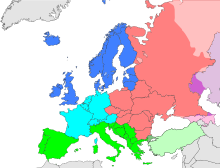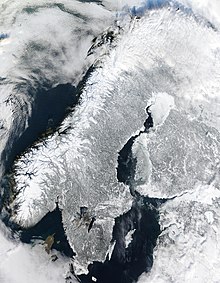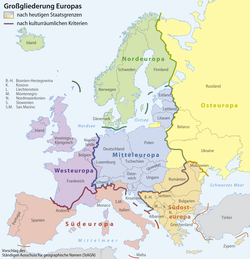Nordeuropa



Nordeuropa ist ein zusammenfassender Begriff für alle nördlich gelegenen Länder Europas.
Zugehörige Staaten
Umgangssprachlich sind in Deutschland mit dem Begriff „Nordeuropa“ meistens die Nordischen Länder gemeint. Unstrittig ist die Zugehörigkeit von Staaten wie Island, Norwegen, Schweden, Dänemark und Finnland.
Weitere Begriffsdefinition
Oft werden auch die baltischen Staaten Estland, Lettland und Litauen, der Norden des europäischen Russlands und der nördliche Teil des Vereinigten Königreichs (Schottland) hinzugerechnet. Zieht man die Grenzen noch weiter, könnten auch Irland, Flandern, die Niederlande und die Tiefebenen Norddeutschlands und Polens als Teil Nordeuropas gesehen werden.
Zugehörigkeit Norddeutschlands
Im naturräumlichen (Prägung durch die letzte Kaltzeit), historischen und architektonischen Kontext wird Norddeutschland teilweise auch als Teil Nordeuropas betrachtet, etwa in verschiedenen Beiträgen des Norddeutschen Rundfunks.[1][2]
Ländergruppen
Politisch kann Nordeuropa folgendermaßen unterteilt werden:
- Skandinavien mit Norwegen, Schweden und Dänemark (ohne Färöer und Grönland).
- Die zu Europa gehörigen Nordischen Länder, womit die skandinavischen Länder sowie Färöer, Finnland und Island gemeint sind. Grönland zählt zwar zu den Nordischen Ländern, aber nicht zu Europa.
- Innerhalb der EU werden Dänemark, Finnland, Belgien, die Niederlande und Schweden zur sogenannten Nordgruppe gezählt.
- Baltikum mit Estland, Lettland und Litauen.
- Nordosteuropa mit Nordwestrussland.
- Der in der deutschen Sprache selten gebrauchte Begriff Nordwesteuropa umfasst das Vereinigte Königreich und Irland, manchmal zusätzlich noch die Bretagne, die Normandie, Flandern und die Niederlande. All diese Länder werden in Deutschland aber in der Regel als Teil Westeuropas gesehen.
Sprachfamilien
Sprachlich gehören diese Gebiete entweder zur germanischen, zur finno-ugrischen, zur baltischen oder keltischen Familie.
Definition der UN
Nach Einteilung der UN umfasst die Region Nordeuropa in alphabetischer Reihenfolge Åland, Dänemark, Estland, die Färöer, Finnland, Island, Irland und Man, die Kanalinseln mit Guernsey, Jersey und Sark, Lettland, Litauen, Norwegen, Schweden, Spitzbergen mit Jan Mayen sowie das Vereinigte Königreich.[3]
Siehe auch
- Liste von Märchen aus Nordeuropa
Weblinks
Einzelnachweise
- ↑ Güstrow wird im Artikel des NDR als Teil Nordeuropas bezeichnet
- ↑ Die Festung Dömitz wird im Artikel des NDR als Festung in Nordeuropa bezeichnet
- ↑ Composition of macro geographical (continental) regions, geographical sub-regions, and selected economic and other groupings. The United Nations Statistics Division, 1. April 2010, abgerufen am 18. September 2010 (englisch).
Auf dieser Seite verwendete Medien
Autor/Urheber: Kolja21
Subregionen Europas (nach UN Geoschema)
Autor/Urheber: NordNordWest, Lizenz: CC BY-SA 3.0
Großgliederung Europas, Vorschlag des Ständigen Ausschuss für geographische Namen (StAGN)
Skandinavien im Winter vom Weltraum aus.
Das Moderate-resolution Imaging Spectroradiometer (MODIS) des NASA Satelliten Terra nahm dieses Bild der Skandinavischen Halbinsel am 19. Februar 2003 auf.
Mit einer größtenteils in der letzten Eiszeit von Gletschern geformten Landschaft ist die Skandinavische Halbinsel im Winter so malerisch, wie es kalt ist.
Auf der westlichen Seite der Halbinsel kann man zerklüftete Buchten, die als Fjorde bezeichnet werden, sehen, welche Norwegens Küste säumen. Viele dieser Fjorde sind mehr als 600 Meter tief und wurden von sehr schweren, dicken Gletschern, die sich während der letzten Eiszeit gebildet hatten, geformt. Die Gletscher flossen die Berge hinab und gruben dabei Täler in Norwegens Küste, die bis weit unter die Meereshöhe reichen. Als die Gletscher schmolzen, floss das Meerwasser in die tiefen Täler hinein und bildete dadurch die Fjorde. Der tiefste Fjord der norwegischen Küste, der Sognefjord, liegt im Südwesten Norwegens und ist 1308 m tief.



